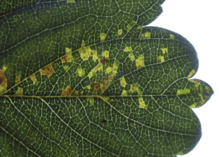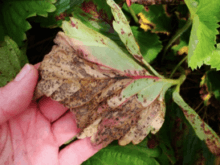Xanthomonas fragariae
Xanthomonas fragariae is a species of proteobacteria. It is a leaf spot disease found in strawberries (Fragaria spp.).[1]
| Xanthomonas fragariae | |
|---|---|
| Scientific classification | |
| Domain: | Bacteria |
| Phylum: | Proteobacteria |
| Class: | Gammaproteobacteria |
| Order: | Xanthomonadales |
| Family: | Xanthomonadaceae |
| Genus: | Xanthomonas |
| Species: | X. fragariae |
| Binomial name | |
| Xanthomonas fragariae Kennedy and King 1962 | |
Host & symptoms
Infection caused by the angular leaf spot pathogen first appears as water-soaked lesions found on the lower surface of strawberry leaves. These water-soaked lesions are the result of bacterial colonization within the plant leaf tissue. Lesions typically get larger as the infection worsens, and the enlarged lesions then form translucent spots. These angular spots typically exude an ooze of bacteria that appears as a white and flakey film once dry.[2] Lesions on the upper surface of leaves will also become visible with time. As the disease worsens, the angular spots grow larger and begin to combine. Severely affected leaves can tear away and become jagged, with a dry and reddish-brown appearance. Prolonged wetness on strawberry leaves can exacerbate this disease, so air circulation and sunlight exposure are important to protecting the host plants. These symptoms are similar to leaf scorch and common leaf spot so be careful when examining symptoms of diseased plants.[3] Dark purple spots scattered on the leaf surface are symptoms of leaf scorch and common leaf spot, but not angular leaf spot.[2]


Diagnosis
Place suspected diseased leaves up against a bright light to see the translucent spots associated with Xanthomonas fragariae.[4] By looking from the backside of infected leaves, light should pass through the angular shaped lesions and appear as lighter colored patches.
Disease cycle
The primary source of inoculum is previously infected debris and necrotic plant tissue, as the pathogen itself cannot freely survive in the soil.[5] Strawberry plants that suffer from systemic infection unfortunately have the bacteria in their vascular system. In spring, after the crowns of infected live plants overwinter, the vascularized bacteria become active and begin inducing symptoms. Bacteria oozes out of the leaf lesions, causing the disease to spread when rain splashes the bacteria onto other susceptible plants and enters through natural openings or wounds. [6]
Management
Chemical controls are ineffective against this disease, and the use of copper containing compounds can cause phytotoxicity in the plants. It is best to destroy infected leaves, plants, and debris immediately by burning or burying it.[3] Cultural controls can include choosing a growing site with adequate air circulation, low humidity, and moderate daytime temperatures to promote the drying of plant leaves. Also try to limit the surrounding weeds so that air circulation is not compromised, and use overhead irrigation if available. Avoid harvesting or moving equipment when fields are wet to limit wounding on susceptible plants. Although there are no completely resistant cultivars, using less susceptible cultivars can be a helpful preventative measure. Allstar, Annapolis, Cavendish, Honeoye, and Kent are the least resistant to the disease and should be planted with high caution.[4] Relatively recent studies by Turecheck et al.[5] have shown heat treatments to be successful in dealing with angular leaf spot. They found that the number of living Xanthomonas fragariae were reduced by a minimum of 105-106 CFU/ml after exposing infected plants to heat treatments of 44-48o C for 2–4 hours.[6] At temperatures this high, this bacterial pathogen can be killed on infected plants. It is still unclear how these treatments would be conducted on commercial scales however, so other modes of control are being investigated.
References
- Garrity, George M. (2005). Bergey's manual of systematic bacteriology, Volume Two: The Proteobacteria, Part B: The Gammaproteobacteria. New York: Springer ISBN 0-387-24144-2.
- "Leaf Scorch of Strawberry | NC State Extension Publications". content.ces.ncsu.edu. Retrieved 2017-12-08.
- "Angular Leaf Spot of Strawberry". Wisconsin Horticulture. Retrieved 2017-10-20.
- "Angular Leaf Spot of Strawberry (Bacterial Blight) | Ohioline". ohioline.osu.edu. Retrieved 2017-10-21.
- Turechek, William W.; Peres, Natalia A. "Heat Treatment Effects on Strawberry Plant Survival and Angular Leaf Spot, Caused byXanthomonas fragariae, in Nursery Production". Plant Disease. 93 (3): 299–308. doi:10.1094/pdis-93-3-0299.
- Turechek, William W.; Peres, Natalia A. "Heat Treatment Effects on Strawberry Plant Survival and Angular Leaf Spot, Caused byXanthomonas fragariae, in Nursery Production". Plant Disease. 93 (3): 299–308. doi:10.1094/pdis-93-3-0299.
- Peres, Natalia A. (2015-01-27). "Angular Leaf Spot of Strawberries". edis.ifas.ufl.edu. Retrieved 2017-10-19.